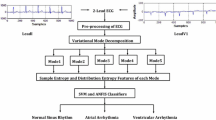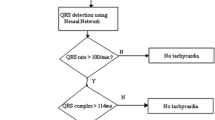Abstract
The aim of this study is to develop an embedded method for automatic diagnosis of ventricular fibrillation (VF) using a neuro-fuzzy system embedded in an automated external defibrillator (AED). To diagnose VF using AEDs, we use the neural network with weighted fuzzy membership functions (NEWFM), a wavelet transform (WT), a sequential increment method (SIM), and phase-space reconstruction (PSR) in order to classify normal sinus rhythm (NSR) and VF of electrocardiogram (ECG) episodes. This study has the following key points. The first contribution is the extraction of peaks from ECG episodes by the use of the WT and SIM by a time–frequency technique. The second contribution is that NSR and VF are distinguished by means of three-dimensional (3D) PSR based on a 3D graphic model. The third contribution is the identification of feature differences between NSR and VF by the use of graphical characteristics of weighted fuzzy membership functions (WFMs) supported by the NEWFM. The final contribution is the development of a neuro-fuzzy system for automatic diagnosis of VF using the WFMs embedded in the AED. The following four preprocessing steps are implemented to extract features from ECG episodes. In the first step, the WT is used for multi-scale representation and analysis and wavelet coefficients are then generated from the ECG episodes. In the second step, the SIM is used to extract peaks from the wavelet coefficients. In the third step, successive peaks are plotted in a 3D phase-space diagram by performing 3D PSR. In the final step, the distance between the origin (0, 0, 0) and the successive peaks plotted in a 3D phase-space diagram is calculated; then, 20 features are extracted from the calculated distances using statistical methods, including frequency distributions and their variability. The 20 extracted features are applied as inputs to the NEWFM, and the result is that the classification accuracy of the NEWFM is 100 %.












Similar content being viewed by others
Explore related subjects
Discover the latest articles, news and stories from top researchers in related subjects.References
Afonso, V.X., Tompkins, W.J.: Detection ventricular fibrillation. IEEE Eng. Med. Biol. Mag. 14, 152–159 (1995)
Watson, A.M., Kannankeril, P.J., Meredith, M.: Emergency response planning and sudden cardiac arrests in high schools after automated external defibrillator legislation. J. Pediatr. 163, 1624–1627 (2013)
Atkins, D.L., Scott, W.A., Blaufox, A.D., Law, I.H., Dick II, M., Geheb, F., Sobh, J., Brewer, J.E.: Sensitivity and specificity of an automated external defibrillator algorithm designed for pediatric patients. Resuscitation 76, 168–174 (2008)
Oiws, M.I., Abou-Zied, A.H., Youssef, A.M.: Study of features based on nonlinear dynamical modeling in ECG arrhythmia detection and classification. IEEE Trans. Biomed. Eng. 29, 733–736 (2002)
Small, M., Yu, D., Harrison, R.G., Robertson, C., Clegg, G., Holzer, M.: Deterministic nonlinearity in ventricular fibrillation. Chaos 10, 268–277 (2000)
Nikolopoulos, S., Alexandridi, A., Nikolakeas, S., Manisc, G.: Experimental analysis of heart rate variability of long-recording electrocardiograms in normal subjects and patients with coronary artery disease and normal left ventricular function. J. Biomed. Inform. 36, 202–217 (2003)
Xie, H.B., Gao, Z.M., Liu, H.: Classification of ventricular tachycardia and fibrillation using fuzzy similarity-based approximate entropy. Expert Syst. Appl. 38, 3973–3981 (2011)
Kong, D.R., Xie, H.B.: Use of modified sample entropy measurement to classify ventricular tachycardia and fibrillation. Measurement 44, 653–662 (2011)
Anas, E.M.A., Lee, S.Y., Hasan, K.: Exploiting correlation of ECG with certain EMD functions for discrimination of ventricular fibrillation. Comput. Biol. Med. 41, 110–114 (2011)
Amann, A., Tratnig, R., Unterkofler, K.: A new ventricular fibrillation detection algorithm for automated external defibrillators. Comput. Cardiol. 32, 559–562 (2005)
Barro, S., Ruiz, R., Cabello, D., Mira, J.: Algorithmic sequential decision-making in the frequency domain for life threatening ventricular arrhythmias and imitative artifacts: a diagnostic system. J. Biomed. Eng. 11, 320–328 (1989)
Übeyli, E.D.: Adaptive neuro-fuzzy inference system for classification of ECG signals using Lyapunov exponents. Comput. Methods Programs Biomed. 93, 313–321 (2009)
Avci, E., Hanbay, D., Varol, A.: An expert discrete wavelet adaptive network based fuzzy inference system for digital modulation recognition. Expert Syst. Appl. 33, 582–589 (2007)
Schölkopf, B., Smola, A.J., Williamson, R.C., Bartlett, P.L.: New support vector algorithms. Neural Comput. 12, 1207–1245 (2000)
Castillo, O., Melin, P., Ramírez, E., Soria, J.: Hybrid intelligent system for cardiac arrhythmia classification with Fuzzy K-Nearest Neighbors and neural networks combined with a fuzzy system. Expert Syst. Appl. 39, 2947–2955 (2012)
Übeyli, E.D.: Recurrent neural networks employing Lyapunov exponents for analysis of ECG signals. Expert Syst. Appl. 37, 1192–1199 (2010)
Melin, P., Amezcua, J., Valdez, F., Castillo, O.: A new neural network model based on the LVQ algorithm for multi-class classification of arrhythmias. Inf. Sci. 279, 483–497 (2014)
Özbay, Y., Ceylan, R., Karlik, B.: A fuzzy clustering neural network architecture for classification of ECG arrhythmias. Comput. Biol. Med. 36, 376–388 (2006)
Engin, M.: ECG beat classification using neuro-fuzzy network. Pattern Recogn. Lett. 25, 1715–1722 (2004)
Meau, Y.P., Ibrahim, F., Narainasamy, S.A.L., Omar, R.: Intelligent classification of electrocardiogram (ECG) signal using extended Kalman Filter (EKF) based neuro fuzzy system. Comput. Methods Programs Biomed. 82, 157–168 (2006)
Martis, R.J., Acharya, U.R., Lim, C.M.: ECG beat classification using PCA, LDA, ICA and discrete wavelet transform. Biomed. Signal Process. Control 8, 437–448 (2013)
Thomas, M., Das, M.K., Ari, S.: Automatic ECG arrhythmia classification using dual tree complex wavelet based features. AEU Int. J. Electron. Commun. 69, 715–721 (2015)
Roopaei, M., Boostani, R., Sarvestani, R.R., Taghavi, M.A., Azimifar, Z.: Chaotic based reconstructed phase space features for detecting ventricular fibrillation. Biomed. Signal Process. Control 5, 318–327 (2010)
Wang, J.-S., Chiang, W.-C., Hsu, Y.-L., Yang, Y.-T.C.: ECG arrhythmia classification using a probabilistic neural network with a feature reduction method. Neurocomputing 116, 38–45 (2013)
Amann, A., Tratnig, R.T., Unterkofler, K.: Detecting ventricular fibrillation by time-delay methods. IEEE Trans. Biomed. Eng. 54, 174–177 (2007)
Lim, J.S.: Finding features for real-time premature ventricular contraction detection using a fuzzy neural network system. IEEE Trans. Neural Netw. 20, 522–527 (2009)
Lee, S.-H., Lim, J.S.: Parkinson’s disease classification using gait characteristics and wavelet-based feature extraction. Expert Syst. Appl. 39, 7338–7344 (2012)
Moody, G.B., Mark, R.G.: The impact of the MIT-BIH arrhythmia database. IEEE Eng. Med. Biol. 20, 45–50 (2001)
Barakat, S., Eteiba, M.B., Wahba, W.I.: Fault location in underground cables using ANFIS nets and discrete wavelet transform. J. Electr. Syst. Inform. Technol. 1, 198–211 (2014)
Uzunoglu, M., Alam, M.S.: Modeling and analysis of an FC/UC hybrid vehicular power system using a novel-wavelet-based load sharing algorithm. Trans. Energy Conv. 23, 263–272 (2008)
Abo-Zahhad, M., Al-Ajlouni, A.F., Ahmed, S.M., Schilling, R.J.: A new algorithm for the compression of ECG signals based on mother wavelet parameterization and best-threshold levels selection. Digit. Signal Proc. 23, 1002–1011 (2013)
Rai, H.M., Trivedi, A., Shukla, S.: ECG signal processing for abnormalities detection using multi-resolution wavelet transform and Artificial Neural Network classifier. Measurement 46, 3238–3246 (2013)
Karimipour, A., Homaeinezhad, M.R.: Real-time electrocardiogram P-QRS-T detection–delineation algorithm based on quality-supported analysis of characteristic templates. Comput. Biol. Med. 52, 153–165 (2014)
Takens, F.: Detecting strange attractors in turbulence. In: Rand, D., Young, L.-S. (eds.) Dynamical Systems and Turbulence, Warwick 1980, pp. 366–381. Springer, Berlin (1981)
Acknowledgments
This research was supported by Basic Science Research Program through the National Research Foundation of Korea (NRF) funded by the Ministry of Education (NRF-2014R1A1A2054293).
Author information
Authors and Affiliations
Corresponding author
Rights and permissions
About this article
Cite this article
Lee, SH. Development of Ventricular Fibrillation Diagnosis Method Based on Neuro-fuzzy Systems for Automated External Defibrillators. Int. J. Fuzzy Syst. 19, 440–451 (2017). https://doi.org/10.1007/s40815-016-0174-0
Received:
Revised:
Accepted:
Published:
Issue Date:
DOI: https://doi.org/10.1007/s40815-016-0174-0




